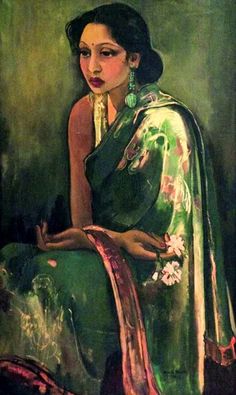
Amrita Sher-Gil was a Hungarian-Indian painter. She has been called “one of the greatest avant-garde women artists of the early 20th century” and a “pioneer” in modern Indian art. Drawn to painting from an early age, Sher-Gil started getting formal lessons in the art, at the age of eight. She first gained recognition at the age of 19, for her oil painting titled Young Girls (1932).
In 1923, Marie came to know an Italian sculptor, who was living at Shimla at the time. In 1924, when he returned to Italy, she too moved there along with Amrita and got her enrolled at Santa Annunziata, an art school at Florence. Though Amrita didn’t stay at this school for long and returned to India in 1924, it was here that she was exposed to works of Italian masters.
At sixteen, Sher-Gil sailed to Europe with her mother to train as a painter at Paris, first at the Académie de la Grande Chaumière under Pierre Vaillent and Lucien Simon (where she met Boris Taslitzky) and later at the École des Beaux-Arts (1930–34). She drew inspiration from European painters such as Paul Cézanne and Paul Gauguin, while working under the influence of her teacher Lucien Simon and the company of artist friends and lovers like Tazlitsky. While in Paris, she is said to have painted with a conviction and maturity rarely seen in a 16-year old.
In 1931, Sher-Gil was briefly engaged to Yusuf Ali Khan, but rumors spread that she was also having an affair with her first cousin and later husband Viktor Egan. Her letters reveal same-sex affairs.
Looking at the Indian art with a fresh eye, Amrita Sher-Gil became excited by the Indian miniature traditions as well as the Mughal and Ajanta paintings. While traveling to the southern parts of India, she became deeply moved by the plight of the unprivileged people she met along the way. This propelled a dramatic shift in her visual language and subject matter. She started using a palette saturated with intense reds, ochres, browns, yellows and greens and depicting her land and its people, giving voice and validity to their experiences.
Picture Credit : Google

